
An elusive giant: A new species of Vitreorana Guayasamin et al., 2009 (Anura: Centrolenidae) from the northern Atlantic Forest with an osteological description and comments on integumentary spicules
We describe a new species of Vitreorana from the Atlantic Forest of southern Bahia state, in north-eastern Brazil. Vitreorana assuh sp. nov. is by far the largest species of the genus (snout-to-vent length [SVL] = 30.9 mm and 34.1 mm in one male and female, respectively; maximum SVL recorded for all other species = 28.0 mm). The new species is morphologically most similar to V. franciscana, from the Cerrado biome in Brazil. Besides its large size, the new species has, among other diagnostic characters, the presence of vomerine teeth and the occurrence of enameled iridophores in the pericardium, hepatic and urinary bladder peritonea. Furthermore, we describe and compare the complete mineralized skeleton of the new species and V. uranoscopa, and describe and discuss the variation of integumentary spicules in all species of the genus and their relevance to Vitreorana systematics.






